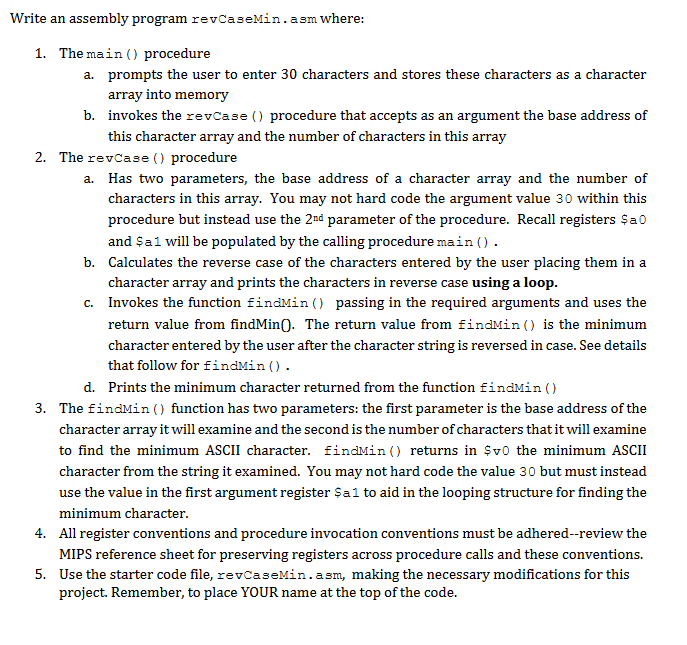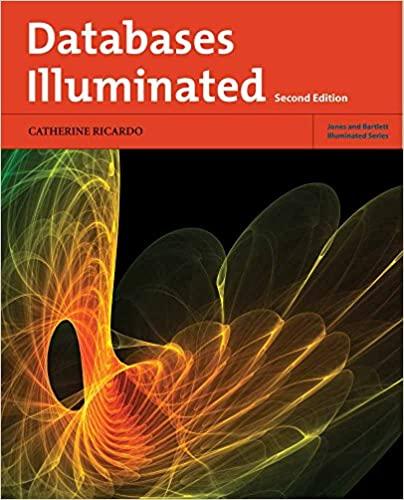Question
The stater file : .data # data segment .align 2 # align the next string on a word boundary outpAuth: .asciiz This is YourFirstName YourLastName

The stater file :
.data # data segment .align 2 # align the next string on a word boundary outpAuth: .asciiz "This is YourFirstName YourLastName presenting revCaseMin. " outpPrompt: .asciiz "Please enter 30 characters (upper/lower case mixed): " .align 2 #align next prompt on a word boundary outpStr: .asciiz "You entered the string: " .align 2 # align users input on a word boundary varStr: .space 32 # will hold the user's input string thestring of 20 bytes # last two chars are \0 (a new line and null char) # If user enters 31 characters then clicks "enter" or hits the # enter key, the will not be inserted into the 21st element # (the actual users character is placed in 31st element). the # 32nd element will hold the \0 character. # .byte 32 will also work instead of .space 32 .align 2 # align next prompt on word boundary outpStrRev: .asciiz "Your string in reverse case is: " .align 2 # align the output on word boundary varStrRev: .space 32 # reserve 32 characters for the reverse case string .align 2 # align on a word boundary outpStrMin: .asciiz "The min ASCII character after reversal is: " # .text # code section begins .globl main main: # # system call to display the author of this code # la $a0,outpAuth # system call 4 for print string needs address of string in $a0 li $v0,4 # system call 4 for print string needs 4 in $v0 syscall
# # system call to prompt user for input # la $a0,outpPrompt # system call 4 for print string needs address of string in $a0 li $v0,4 # system call 4 for print string needs 4 in $v0 syscall # # system call to store user input into string thestring # li $v0,8 # system call 8 for read string needs its call number 8 in $v0 # get return values la $a0,varStr # put the address of thestring buffer in $t0 li $a1,32 # maximum length of string to load, null char always at end # but note, the is also included providing total len
# Exit gracefully from main() li $v0, 10 # system call for exit syscall # close file ################################################################ # revCase() procedure can go next ################################################################ # Write code to reverse the case of the string. The base address of the # string should be in $a0 and placed there by main(). main() should also place into # $a1 the number of characters in the string. # You will want to have a label that main() will use in its jal # instruction to invoke revCase, perhaps revCase: # revCase:
# # After reversing the string, you may print it with the following code. # This is the system call to display "Your string in reverse case is: " la $a0,outpStrRev # system call 4 for print string needs address of string in $a0 li $v0,4 # system call 4 for print string needs 4 in $v0 syscall # system call to display the user input that is in reverse case saved in the varRevStr buffer la $a0,varStrRev # system call 4 for print string needs address of string in $a0 li $v0,4 # system call 4 for print string needs 4 in $v0 syscall
# # Your code to invoke findMin() can go next
# Your code to return to the caller main() can go next
################################################################ # findMin() function can go next ################################################################ # Write code to find the minimum character in the string. The base address of the # string should be in $a0 and placed there by revCase. revCase() should also place into # $a1 the number of characters in the string. # You will want to have a label that revCase() will use in its jal # instruction to invoke revCase, perhaps findMin: # # findMin: # write use a loop and find the minimum character
# # system call to display "The min ASCII character after reversal is: " la $a0,outpStrMin # system call 4 for print string needs address of string in $a0 li $v0,4 # system call 4 for print string needs 4 in $v0 syscall
# write code for the system call to print the the minimum character
# write code to return to the caller revCase() can go next
Write an assembly program revCaseMin.asm where: 1. The main) procedure a. prompts the user to enter 30 characters and stores these characters as a character array into memory b. invokes the revCase() procedure that accepts as an argument the base address of this character array and the number of characters in this array 2. The revCase) procedure Has two parameters, the base address of a character array and the number of characters in this array. You may not hard code the argument value 30 within this procedure but instead use the 2nd parameter of the procedure. Recall registers a0 a. and $a1 will be populated by the calling procedure main ( ) . b. Calculates the reverse case of the characters entered by the user placing them in a character array and prints the characters in reverse case using a loop Invokes the function findMin) passing in the required arguments and uses the return value from findMin0. The return value from findMin () is the minimum character entered by the user after the character string is reversed in case. See details c. that follow for findin ( ) . d. Prints the minimum character returned from the function findMin () 3. The findMin () function has two parameters: the first parameter is the base address of the character array it will examine and the second is the number of characters thatit will examine to find the minimum ASCII character. findMin) returns in $v0 the minimum ASCII character from the string it examined. You may not hard code the value 30 but must instead use the value in the first argument register Sal to aid in the looping structure for finding the minimum character 4. All register conventions and procedure invocation conventions must be adhered-review the MIPS reference sheet for preserving registers across procedure calls and these conventions. 5. Use the starter code file, revCaseMin.asm, making the necessary modifications for this project. Remember, to place YOUR name at the top of the code. Write an assembly program revCaseMin.asm where: 1. The main) procedure a. prompts the user to enter 30 characters and stores these characters as a character array into memory b. invokes the revCase() procedure that accepts as an argument the base address of this character array and the number of characters in this array 2. The revCase) procedure Has two parameters, the base address of a character array and the number of characters in this array. You may not hard code the argument value 30 within this procedure but instead use the 2nd parameter of the procedure. Recall registers a0 a. and $a1 will be populated by the calling procedure main ( ) . b. Calculates the reverse case of the characters entered by the user placing them in a character array and prints the characters in reverse case using a loop Invokes the function findMin) passing in the required arguments and uses the return value from findMin0. The return value from findMin () is the minimum character entered by the user after the character string is reversed in case. See details c. that follow for findin ( ) . d. Prints the minimum character returned from the function findMin () 3. The findMin () function has two parameters: the first parameter is the base address of the character array it will examine and the second is the number of characters thatit will examine to find the minimum ASCII character. findMin) returns in $v0 the minimum ASCII character from the string it examined. You may not hard code the value 30 but must instead use the value in the first argument register Sal to aid in the looping structure for finding the minimum character 4. All register conventions and procedure invocation conventions must be adhered-review the MIPS reference sheet for preserving registers across procedure calls and these conventions. 5. Use the starter code file, revCaseMin.asm, making the necessary modifications for this project. Remember, to place YOUR name at the top of the codeStep by Step Solution
There are 3 Steps involved in it
Step: 1

Get Instant Access to Expert-Tailored Solutions
See step-by-step solutions with expert insights and AI powered tools for academic success
Step: 2

Step: 3

Ace Your Homework with AI
Get the answers you need in no time with our AI-driven, step-by-step assistance
Get Started


